One of the largest Classic Maya cities, it reached its apex around 800AD when it was suddenly abandoned, like many other Maya centers during the ninth century. Uxmal is located in the Puuc Hills the region that have given the name to the distinct Puuc-style architecture characterized by the elaborate stone mosaic facades.
Uxmal |
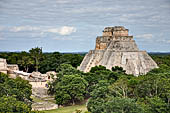
|
The Magician's Pyramid (el Adivino) is the first building which appears as you enter the Zona Arqueologica. Built according to the legend in one night by Itzamna dwarf, the pyramid has highly rounded corners with two steep staircases on the western and on the eastern side.
Walk around to the west face of the pyramid into the Quadrangle of the Birds (Cuadrángulo de los Pájaros), named after the macaws on the roof of the building on the west side. At the center of the patio there is an altar with a column and at the South the recently reconstructed long colonnaded gallery. From the patio the western staircase of the Magician's Pyramid can be seen. Flanked by stylized Chac masks, the staircase leads to the House of the Magician (Temple V) designed as a cave entered though the mouth of the witz monster mask, the living personification of the mountain-pyramid.
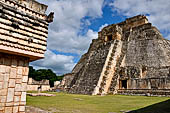
|
Uxmal
|
The Nunnery Quadrangle is formed by four long buildings arranged around a large esplanade.
On the highest level of the esplanade sits the North Building with eleven doorways.
Four stacked masks of the original seven still survive together with two angle masks at its the eastern end.
The first mask stack, above the second door from left, has four masks, the upper mask has teeth instead of the fangs of the other three. The frieze between the first and the second mask stack (third doorway) shows a traditional Yucatec domestic huts surmounted by three double-headed serpents. Above the third and the fourth doorway there is a naked figure of a captive.
The second mask stack has only three masks, with round eyebrows. The frieze over the fifth doorway shows a domestic hut with two headed serpents above and two jaguars with intertwined tails below.
The third mask stack over the central door has four similar masks, on top of the stack it can be noted a partially preserved mask of Tlaloc (the Storm God).
The fourth mask stack, at the eastern end of the façade, is surmounted by an almost completely preserved Tloloc mask. Near the end of the facade you will note a drummer and a human headed bird. The eastern corner stacks masks have four well preserved identical masks with snouts with curled upturned ends, a serpent head is at the bottom.
To the left of Grand Staircase, at the ground level, there is the so-called ‘Temple of Venus’ largely reconstructed with four square monolithic columns. The building at the right of Grand Staircase is known as Building Y.
Uxmal |
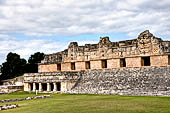
|
The West Building of the Nunnery Quadrangle is entered by a broad stairway running across its entire front. The façade has seven doorways while an elaborate frieze runs all along the upper section. Most of the frieze has been reconstructed and only one section of it is original. The bodies of 2 intertwined serpents run from one side to the other of the façade; a standing figure holding a staff; over doorway no.3 a round feathered base with on top a head; above the central door a turtle-man deity with above a large feathered headdress; over the 2nd doorway from right the original section of the frieze with a mask stack against a background of latticework, a human head, wearing mask, goes out from the open jaws of one of the two entwined serpents of the facade.
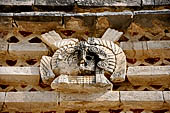
|
Uxmal
|
The West facade of the East Building has six trapezoidal tiers of double-headed serpents with small central masks (owl?) (two of them are missing). At the center over the wider central doorway a mask stack. Mask stacks are present also at the corners of both ends of the building. Walk behind the Eastern building to see the Nunnery annex, a long building on the north of the Quadrangle of Birds.
The South Building, at the lowest level of the complex, has nine doorways opened to the courtyard while a large corbelled arch give access to the compound. The inner façade is decorated with simple traditional Yucatec domestic huts.
From the corbelled archway you reach the small ball court with grassy sloped sidewalls, the ring is a concrete reconstruction.
Uxmal |
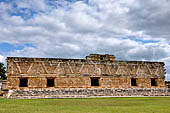
|
Sitting on a high natural platform the Governor Palace (a name not related to its original purpose) is the major structure of Uxmal. A continuous long frieze adorn the upper section of all the four sides of the building. Among the profusion of decoration details we noticed: in the middle of the façade the elaborate feather headdress of Chak against a trapezoidal tier of double-headed serpents, the head and arms are missing while the serpents of the background are covered with astronomical symbols; between 4th and 5th doorways from left the remains of human figure seated on throne with elaborate feathered headdress; above 5th doorway from left the feathered headdress of a missing figure.
The House of the Turtles so called because of the stone turtles on the upper frieze of the façades, symbol of origin and regeneration, birth and rebirth.
In the large esplanade on the east side of the palace there is the mysterious monolith called the Pillory and the two headed jaguar throne.
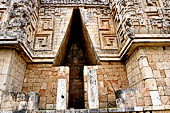
|
Uxmal
|
Built on a natural elevation against the green jungle the Great Pyramid, or Temple of the Macaws climbed by a steep stairway.
Below the Great Pyramid there is the House of the Doves so named because of the numerous holes resembling those used in Spain as nests for the doves.
The Cemetery Group and the House of the Old Woman this one among the oldest construction of Uxmal. According to legend is was the home of mother of the dwarf who built the pyramid of the Magician. In the vicinity under a thatched roof there is a collection of stone phalluses.
Uxmal |
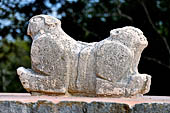
|
|
|
|



